The Southern Pleiades (Theta Carinae Cluster) is a bright, large open star cluster located 486 light-years away in the southern constellation of Carina (the Keel). It lies near the galactic plane and is one of the nearest star clusters to the Sun. It is listed as IC 2602 in the Index Catalogue and Caldwell 102 in the Caldwell catalogue.
With an apparent magnitude of 1.9 and an apparent size of 50 arcminutes, the cluster is easily visible to the unaided eye. It lies in the region of the Diamond Cross, a bright asterism in the far southern sky.
The Theta Carinae Cluster is the fifth brightest star cluster in the night sky. It is only fainter than the Hyades and the Pleiades in the constellation Taurus, the Alpha Persei Cluster in Perseus, and the large Coma Star Cluster in Coma Berenices.
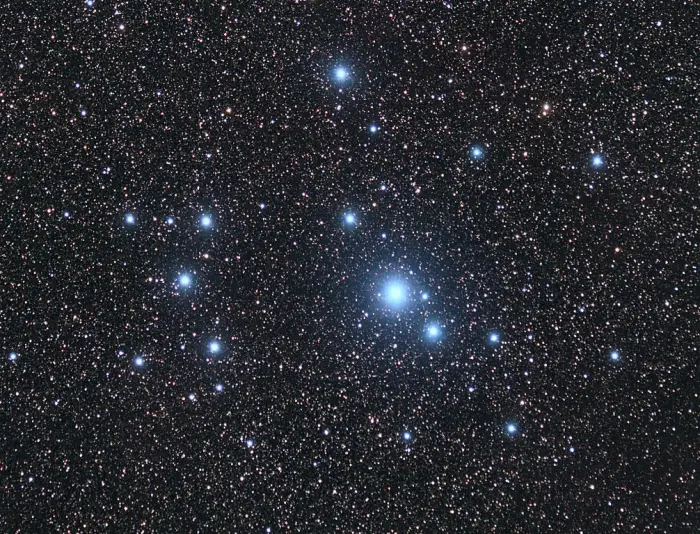
The Southern Pleiades star cluster in Carina, image credit: Tel Lekatsas (CC BY 2.0)
The Southern Pleiades is also one of the nearest open clusters to the Sun. Only the Hyades (153 light-years), the Coma Star Cluster (280 ly) and the Pleiades (444 ly) are closer. The cluster’s brightness and size make it a popular target for amateur astronomers.
The entire cluster contains about 75 stars. These stars are members of the Lower Scorpius-Centaurus association (Sco OB2), the nearest OB association to the solar system. The stars of Sco OB2 lie at an average distance of 420 light-years. They are mostly hot, massive, blue stars, many of which will end their lives as spectacular supernovae. Bright members of the Scorpius-Centaurus association include Acrux and Mimosa in the constellation Crux, Hadar in Centaurus, and Antares and Shaula in Scorpius. These are some of the brightest stars in the sky.
IC 2602 was nicknamed the Southern Pleiades because it is exceptionally bright and lies at a similar distance to the brighter and better-known Pleiades star cluster (Messier 45) in Taurus.
Named after the Seven Sisters in Greek mythology, the northern Pleiades cluster lies in the northern celestial hemisphere. It shines at magnitude 1.6 and occupies 2 degrees of the northern sky at the shoulder of the celestial Bull. Alcyone, the brightest Pleiades star, shines at third magnitude. Other bright members – including Atlas, Electra, Maia, Merope, and Taygeta – shine at fourth and fifth magnitude. Messier 45 is much older than the Southern Pleiades, with an estimated age of 75 to 100 million years. It can be found by extending a line through the three bright stars of Orion’s Belt.
Like its northern counterpart, the Theta Carinae Cluster is composed of many hot, blue, B-type stars with short life spans. The cluster is believed to be only 13.7 million years old, but some of its members are already approaching the end of their main sequence lifetime.
Stars
The brightest members of the Southern Pleiades are visible to the unaided eye. About nine stars are brighter than magnitude 6.5, the lower limit for unaided eye visibility. These include Theta Carinae, PP Carinae, V518 Carinae, HD 93194, and HD 93607. Other cluster members are fainter but can be spotted in binoculars.
Theta Carinae (θ Car), the brightest member of IC 2602, shines at magnitude 2.76 from a distance of 460 light-years. It is the fifth brightest star in Carina, after Canopus (Alpha Carinae), Miaplacidus (Beta Carinae), Avior (Epsilon Carinae), and Aspidiske (Iota Carinae).
Theta Carinae is the primary component in a spectroscopic binary system with the stellar classification B0.5 V, indicating a hot blue main sequence star. With a mass 14.9 times that of the Sun, the star is a supernova candidate. It has a radius of 5.1 solar radii and an estimated age of 35 – 46 million years. With a surface temperature of around 31,000 K, it is 14,500 times more luminous than the Sun.
The spectroscopic companion is believed to be an F-type star. The two stars have the shortest orbital period known – only 2.2 days – among massive stars.
The primary component of the Theta Carinae system is a blue straggler, a so-called born-again star created by a merger or close interaction between two stars. The bright star is believed to have accreted material from its companion, which was originally the more massive of the two stars. As a result, Theta Carinae appears much bluer and younger than the rest of the cluster.
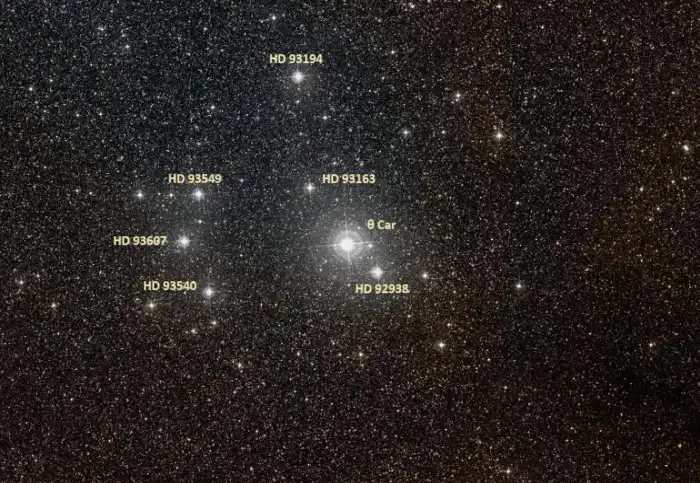
Southern Pleiades stars, image credit: ESO/Digitized Sky Survey 2 (CC BY 4.0)
PP Carinae (p Carinae, HD 91465) is a blue main sequence star of the spectral type B4 Vne. It is classified as a Gamma Cassiopeiae variable, a fast-spinning star with an equatorial disk of expelled material that causes variations in brightness. The star spins at 280 km/s. Its brightness varies from magnitude 3.22 to 3.55.
PP Carinae has a mass of 7.6 solar masses and a radius 7.95 times that of the Sun. With an effective temperature of 17,410 K, it shines with 5,212 solar luminosities. It lies 480 light-years away.
PP Carinae is considered to be a member of the Southern Pleiades, but it does not appear in the same field of view as the cluster’s centre. It appears closer to the Carina Nebula in the sky than to the core group of IC 2602.
V518 Carinae (HD 92938) is a blue main sequence star with the spectral class B3/5V. It shines at magnitude 4.82 from a distance of 450 light-years. It has a mass of 6.2 solar masses and a radius of 3.3 solar radii. It spins at 120 km/s and is 753 times more luminous than the Sun. It is a suspected Gamma Cassiopeiae variable.
HD 93194 has an apparent magnitude of 4.85 and lies 490 light-years away. It has the stellar classification B/3Vn. Like its neighbours, it is an exceptionally fast rotator. It spins at 310 km/s.
The star has 5.4 times the Sun’s mass and a radius of 4.7 solar radii. With an effective temperature of 14,761 K, it has an energy output of 676 Suns.
HD 93607 is a B4-type main sequence star located 491 light-years away. It has an apparent magnitude of 4.87. The 17.5-million-year-old star has a mass 5.9 times that of the Sun and a radius 3.9 times the Sun’s. It is 893 times more luminous than the Sun and has a surface temperature of 16,882 K. It is another fast spinner, with a projected rotational velocity of 160 km/s.
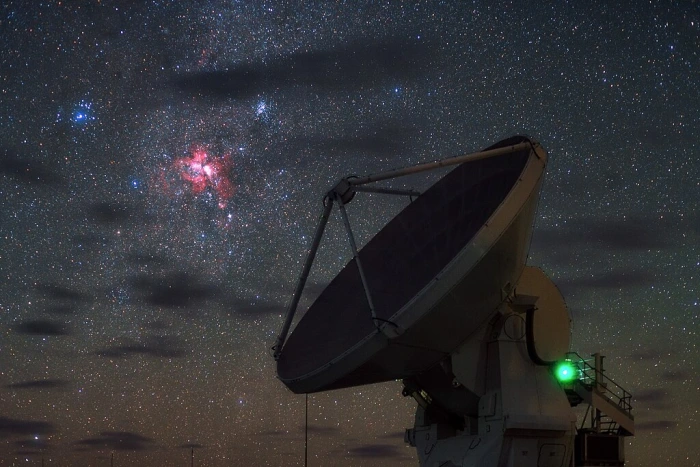
In this wonderful single-exposure image taken during the ESO Ultra HD Expedition, three deep sky objects seem to shine in front of the dish of one of the Atacama Large Millimeter/submillimeter Array (ALMA) high-precision antennas. The most striking feature is the reddish Carina Nebula, also known as NGC 3372. It is a large cloud of gas, mostly hydrogen, in which star formation has recently taken place. The short-lived massive blue stars forged within the nebula emit copious amounts of ultraviolet radiation, which then ionises the surrounding gas and causes the hydrogen atoms to glow with a characteristic red colour. Eventually supernovae and strong stellar winds from the most massive stars will disperse the gas of the Carina Nebula, leaving behind one or more clusters of stars. Two such star clusters, known as NGC 3532 and IC 2602, can be seen respectively to the top right and top left of the Carina Nebula in this image. The three celestial objects belong to the constellation of Carina (The Keel) and were first catalogued by the French astronomer Nicolas Louis de Lacaille. They look close to one another in this image, but actually their distances from us are very different. Image credit: ESO/B. Tafreshi (CC BY 4.0)
Facts
The open cluster IC 2602 was discovered by the French astronomer Nicolas-Louis de Lacaille from the Cape of Good Hope in South Africa in 1751. Abbé Lacaille noted the cluster’s resemblance to the Taurean Pleiades. He observed it in his ½-inch telescope.
IC 2602 is believed to be about the same age as the Omicron Velorum Cluster (IC 2391, Caldwell 85) in the constellation Vela. Located 574 light-years away in the region of the False Cross, the Omicron Velorum Cluster has a similar lithium depletion boundary age of 50 million years. The age of 13.7 million years was estimated for the Theta Carinae Cluster based on its position on the Hertzsprung-Russell diagram, which shows the relationship between the member stars’ absolute magnitudes and luminosities.
In 2020, an international team of astronomers led by L. G. Bouma, Department of Astrophysical Sciences, Princeton University, announced the discovery of a young planet orbiting the star TOI-837 in the Southern Pleiades cluster. The star TOI 837 is a G0/F9 dwarf with an estimated age of around 35 million years. The observation data shows that the exoplanet, TOI-837b, is comparable to Jupiter in size and has an orbital period of 8.3 days. It has a mass of up to 1.20 Jupiter masses. It is one of only a few dozen extrasolar planets found in open clusters.
Location
The Theta Carinae Cluster is easy to find because its brightest member, Theta Carinae, is one of the stars of the Diamond Cross, a relatively conspicuous asterism also formed by Miaplacidus (Beta Carinae), Upsilon and Omega Carinae. Theta Carinae marks the northeastern vertex of the asterism. The bright Carina Nebula appears in the same area and can be found using the stars of the Diamond Cross.
The Diamond Cross appears only a few degrees south of the Milky Way’s band, in the region between two brighter diamond-shaped asterisms, the Southern Cross and the False Cross. The Southern Cross is formed by Acrux, Mimosa, Gacrux, Imai and Ginan in the constellation Crux and lies near the Southern Pointers, Rigil Kentaurus and Hadar, the brightest stars in Centaurus. The larger False Cross is formed by Avior and Aspidiske in Carina with Alsephina and Markeb in Vela.
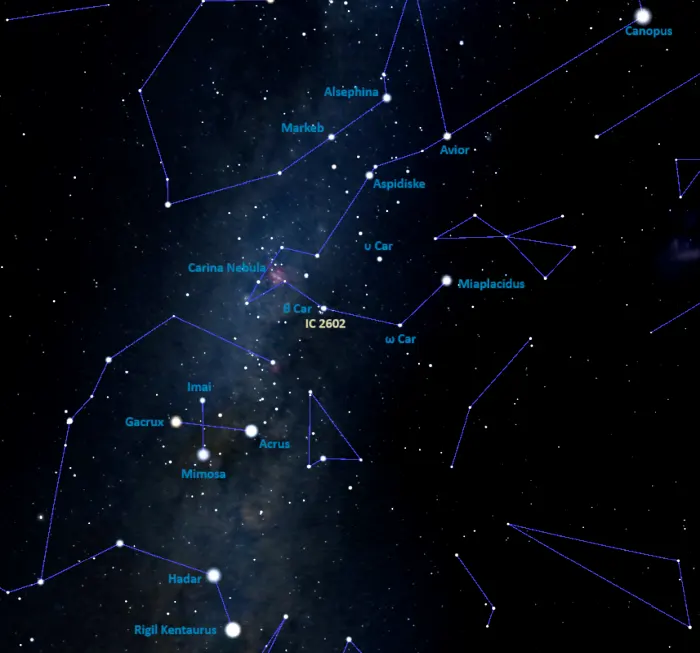
The location of the Southern Pleiades (Theta Carinae Cluster), image: Stellarium
The Theta Carinae Cluster appears in the same region as the Carina Nebula (NGC 3372), the Wishing Well Cluster (NGC 3532), the Running Chicken Nebula (IC 2944), the Statue of Liberty Nebula (NGC 3576), and the Pearl Cluster (NGC 3766).
A fainter open cluster, catalogued as Melotte 101 (Mel 101), appears just south of IC 2602. It has an apparent magnitude of 8.0 and an angular size of 16.3 arcminutes.
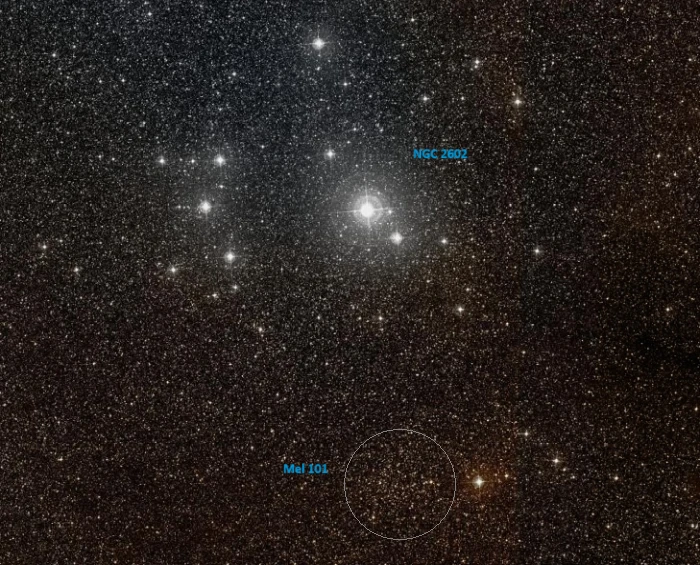
Southern Pleiades and Melotte 101, image credit: ESO/Digitized Sky Survey 2 (CC BY 4.0)
At declination -64°, the Theta Carinae Cluster is only 26 degrees from the south celestial pole and never rises for most observers in the northern hemisphere. It is best seen from the southern hemisphere, where it is circumpolar for observers in the subtropical latitudes. The cluster stays below the horizon for locations north of the latitude 26° N and appears low in the sky for observers in the northern tropical latitudes.
The cluster can be observed in large binoculars or a small telescope. The pattern of stars in the eastern portion of the cluster, visible in a pair of binoculars, bears a resemblance to the hourglass figure of Orion, the Hunter.
The best time of the year to observe the Southern Pleiades and other deep sky objects in Carina is during the month of March, when the constellation climbs higher above the horizon in the early evening.
Southern Pleiades – IC 2602
| Constellation | Carina |
| Object type | Open cluster |
| Right ascension | 10h 42m 27.1s |
| Declination | −64° 25′ 34″ |
| Apparent magnitude | 1.9 |
| Apparent size | 50’ x 50’ |
| Distance | 486 light-years (149 parsecs) |
| Age | 13.7 million years |
| Names and designations | Southern Pleiades, Theta Carinae Cluster, IC 2602, Caldwell 102 (C102), Collinder 229 (Cr 229), Melotte 102 (Mel 102), VDBH 103, C 1041-641, OCl 838.0, MWSC 1841, Theia 92 |